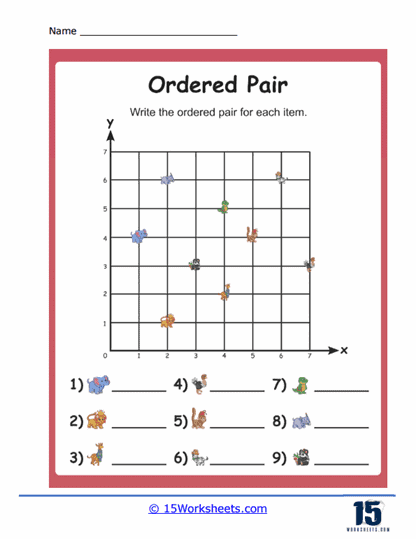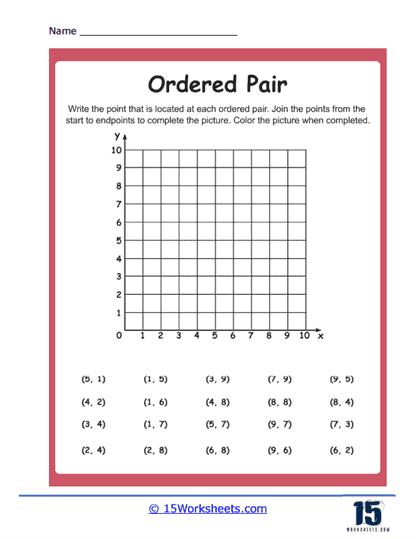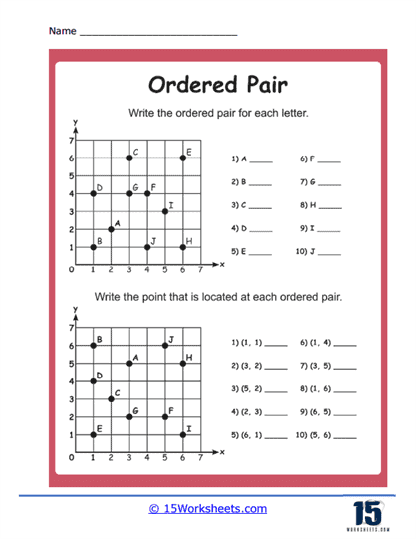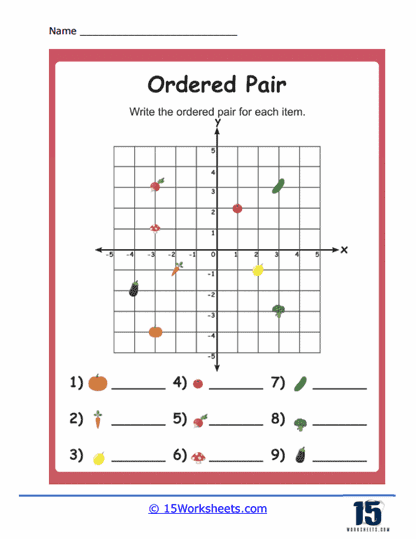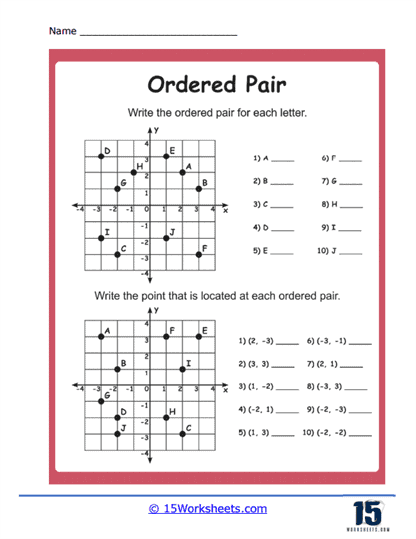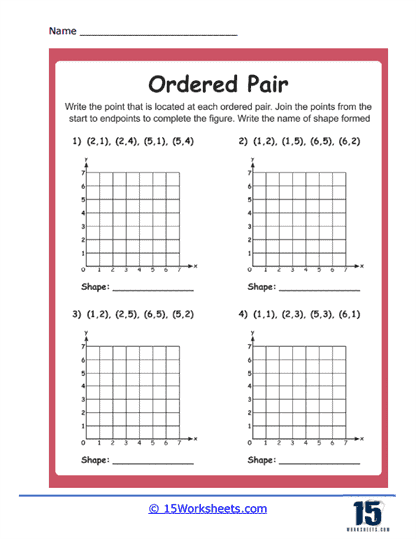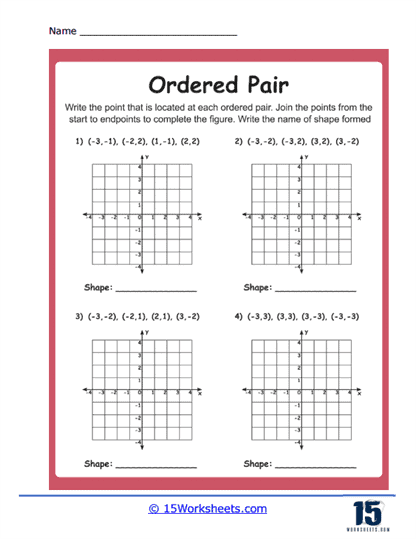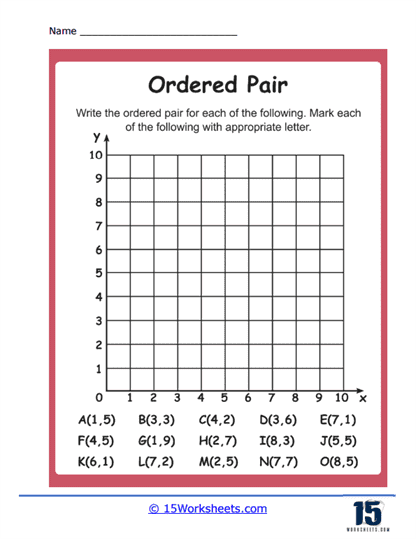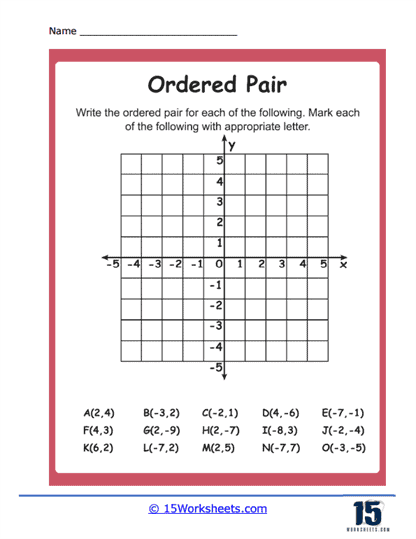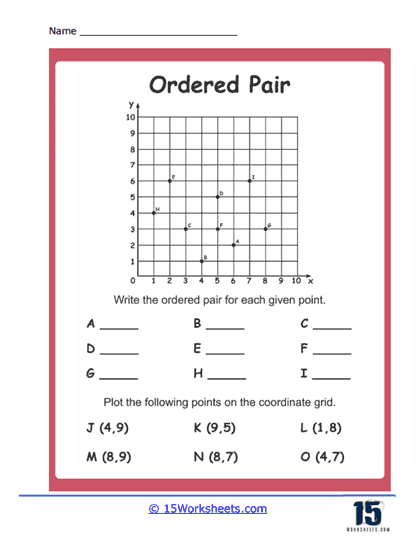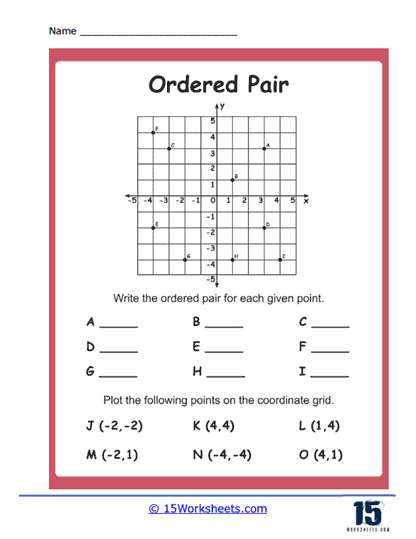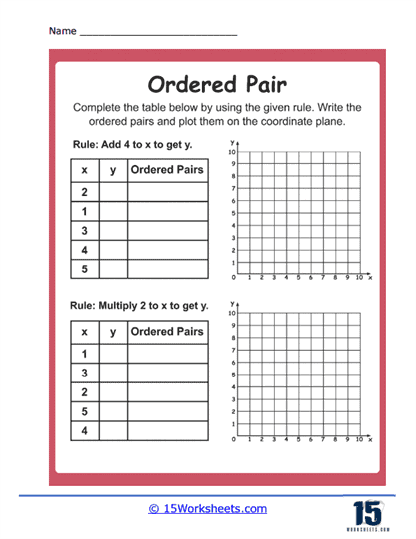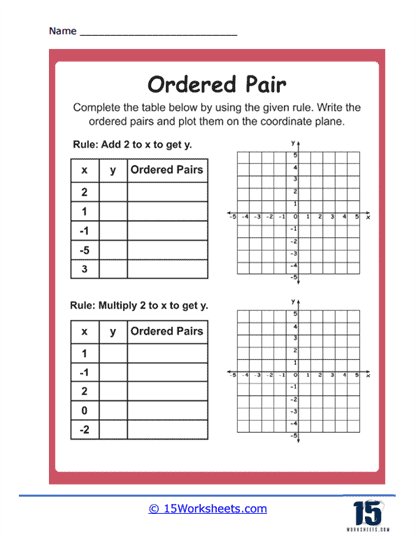Ordered Pairs Worksheets
About These 15 Worksheets
In middle school math, ordered pairs worksheets serve as essential tools that help students master the concept of coordinate systems and the process of plotting points. These worksheets are not merely exercises; they are a bridge to deeper understanding, guiding students to see how mathematics connects to the world around them. Ordered pairs-combinations of two numbers-are the building blocks of this skill. With each pair, students are given a set of instructions on how to navigate the coordinate plane, a two-dimensional surface that opens up countless possibilities for visualizing math. Mastering ordered pairs early on lays the groundwork for more complex topics such as graphing linear equations, geometry, and even real-world problem-solving.
At its core, an ordered pair, denoted as (x, y), provides a specific way to pinpoint a location on the coordinate plane. The first number in the pair, x, represents the horizontal distance from the y-axis, while the second number, y, shows how far the point is from the x-axis vertically. Think of it as a treasure map where “x” tells you how many steps to take to the right or left, and “y” indicates how many steps to move up or down. This seemingly simple process allows students to begin seeing how various points come together to form shapes, lines, and curves, sparking their curiosity about the ways math shapes the world. Through ordered pairs, students learn not just numbers and coordinates, but how to visualize relationships and patterns.
The value of ordered pairs worksheets goes beyond just memorizing the process of placing points on a grid. They engage students in active learning by encouraging them to explore, predict, and test their knowledge. These worksheets often involve interactive exercises where students may be asked to connect dots to form shapes, plot points to uncover hidden pictures, or even solve word problems that require them to apply their knowledge of coordinates to real-life situations. This hands-on approach transforms abstract mathematical concepts into something tangible, making math less intimidating and more relatable. With each worksheet, students gain confidence in their ability to tackle increasingly complex challenges.
Working with ordered pairs hones critical thinking and problem-solving skills. As students become proficient in navigating the coordinate plane, they begin to see patterns and relationships between numbers and positions. This understanding is crucial not just for mathematics but also for subjects like science, where data visualization is key, or computer programming, where coordinate systems are used in developing animations, games, and applications. The ability to interpret and manipulate ordered pairs helps students make connections across disciplines, enhancing their overall academic development and preparing them for a future where analytical thinking is paramount.
This series of ordered pairs worksheets are much more than simple math exercises-they are powerful learning tools that open the door to a deeper understanding of mathematics and its applications. By teaching students how to plot points on a coordinate plane, these worksheets equip them with the skills needed for a wide range of academic and real-world challenges. The precision and problem-solving ability fostered through these exercises build a foundation not only for advanced mathematical concepts but also for critical thinking in various fields. As students move forward in their education, the lessons learned from ordered pairs will continue to shape their analytical abilities and their confidence in tackling new problems.
What Are Ordered Pairs?
Ordered pairs consist of two elements arranged in a specific order, denoted as (a, b), where “a” represents the first element, and “b” represents the second. The critical characteristic of ordered pairs is that the order of the elements carries significance; thus, (a, b) is distinct from (b, a) whenever a ≠ b or when a particular order is specified within a given context. These pairs can encompass elements of various types, such as numbers, variables, or points, drawn from a defined set. In the realm of two-dimensional Cartesian coordinates, (x, y) represents a point in the xy-plane, with “x” denoting the horizontal position (x-coordinate) and “y” indicating the vertical position (y-coordinate). Ordered pairs are the foundational concept for pinpointing locations in coordinate systems.
Let’s delve into the various types of exercises you might expect to find on these worksheets and how they facilitate learning:
1. Plotting Points on a Coordinate Plane – This is usually the first exercise you’ll come across on an ordered pairs worksheet. Here, you’re given a series of ordered pairs, and your job is to plot them on a grid. This exercise gives you hands-on practice with the concept of ordered pairs, helps you understand the importance of the order of the pair (x before y), and familiarizes you with the layout of the coordinate plane.
2. Writing Ordered Pairs for Given Points – Here, a point is plotted on a grid, and you’re asked to provide the corresponding ordered pair. This not only reinforces the concept of ordered pairs but also helps you gain proficiency in reading the coordinate plane.
3. Word Problems involving Ordered Pairs – In these exercises, you’re given a word problem and asked to represent the information as an ordered pair or a set of ordered pairs. You might also be asked to plot these points on a coordinate plane. These problems help to develop critical thinking skills and apply the abstract concept of ordered pairs to real-world situations.
4. Graphing Linear Equations using Ordered Pairs – These exercises involve graphing lines given a linear equation. First, you’re asked to find several ordered pairs that satisfy the equation, then plot these points on the coordinate plane and draw the line that goes through them. This ties together the concept of ordered pairs with the broader topic of graphing linear equations.
5. Identifying Quadrants – The coordinate plane is divided into four sections, known as quadrants. In these exercises, you’re given an ordered pair and asked to identify which quadrant the point belongs to or provide a pair that falls within a specified quadrant. These exercises deepen your understanding of the structure of the coordinate plane.
6. Distance and Midpoint Problems – In these more advanced exercises, you use ordered pairs to find the distance between two points or the midpoint of a line segment. These exercises introduce important concepts in coordinate geometry.
Now, how can ordered pairs worksheets improve students’ abilities?
By working with these worksheets, students can gain a strong understanding of how to locate and plot points on a coordinate plane, a fundamental skill in algebra and geometry. This skill is essential for graphing linear equations, interpreting graphs, and solving real-world problems.
The exercises on these worksheets also enhance a student’s ability to interpret and analyze data. When students plot points derived from word problems or real data, they are making a visual representation of the information that can reveal trends, relationships, and patterns.
Furthermore, the ability to read and interpret graphs is a critical skill not only in mathematics but also in many other disciplines such as science, economics, and social studies. Understanding how data is represented visually can assist in drawing meaningful conclusions from experiments, studies, or statistical information.
Also, ordered pairs worksheets often present problems in a real-world context, which helps students see the relevance and practical application of the math they are learning. This connection can boost students’ interest and engagement in the subject.
How Do You Plot Ordered Pairs?
Step 1) Understand the Ordered Pair
Start by identifying your ordered pair, which should look something like this – (2, 3). In this pair, 2 is the x-coordinate, and 3 is the y-coordinate. This means we’ll move 2 units in the horizontal direction (along the x-axis) and 3 units in the vertical direction (along the y-axis).
Step 2) Locate the Origin
Before you can plot the point, you need to find the origin on the coordinate plane. The origin is the point (0, 0), where the x-axis and y-axis intersect.
Step 3) Move Along the X-Axis
From the origin, count along the x-axis the number of units indicated by the x-coordinate of your ordered pair. If the x-coordinate is positive, count to the right; if it’s negative, count to the left. In our example, since the x-coordinate is 2, you would move two units to the right.
Step 4) Move Along the Y-Axis
From your position on the x-axis, count up or down along the y-axis the number of units indicated by the y-coordinate. If the y-coordinate is positive, count upwards; if it’s negative, count downwards. In our example, the y-coordinate is 3, so you would move three units upwards.
Step 5) Plot the Point
After you’ve moved the correct number of units along both the x and y-axes, you’re ready to plot your point. Mark the point with a dot and label it with the ordered pair for clarity. The point (2, 3) on our coordinate plane is two units to the right of the y-axis and three units above the x-axis.
Step 6) Double Check Your Coordinates
Ensure your plotted point is in the correct position by “reading” its coordinates. Starting from the origin, follow a path along the x and y-axes to your point and confirm these steps correspond to your original ordered pair.

